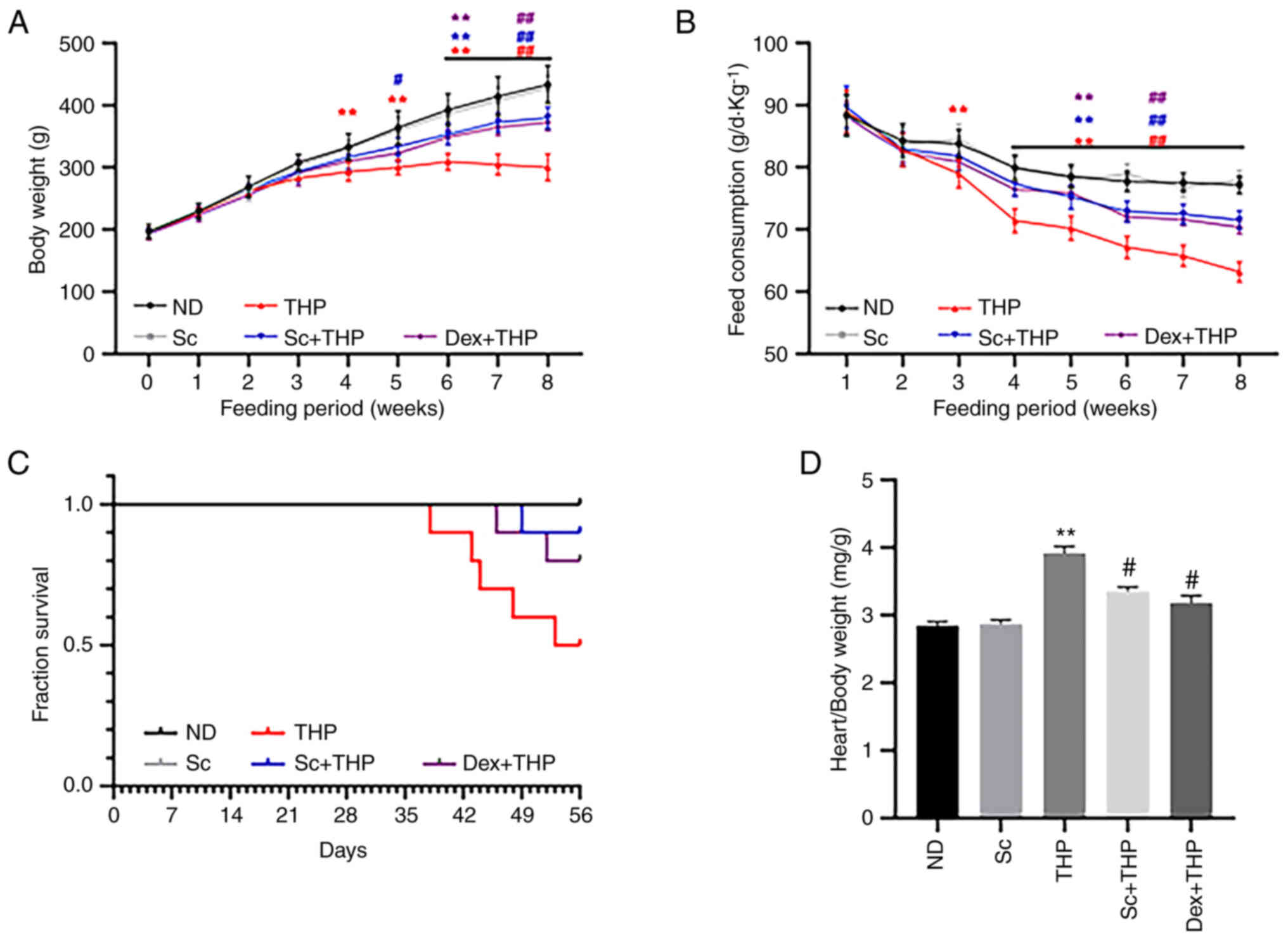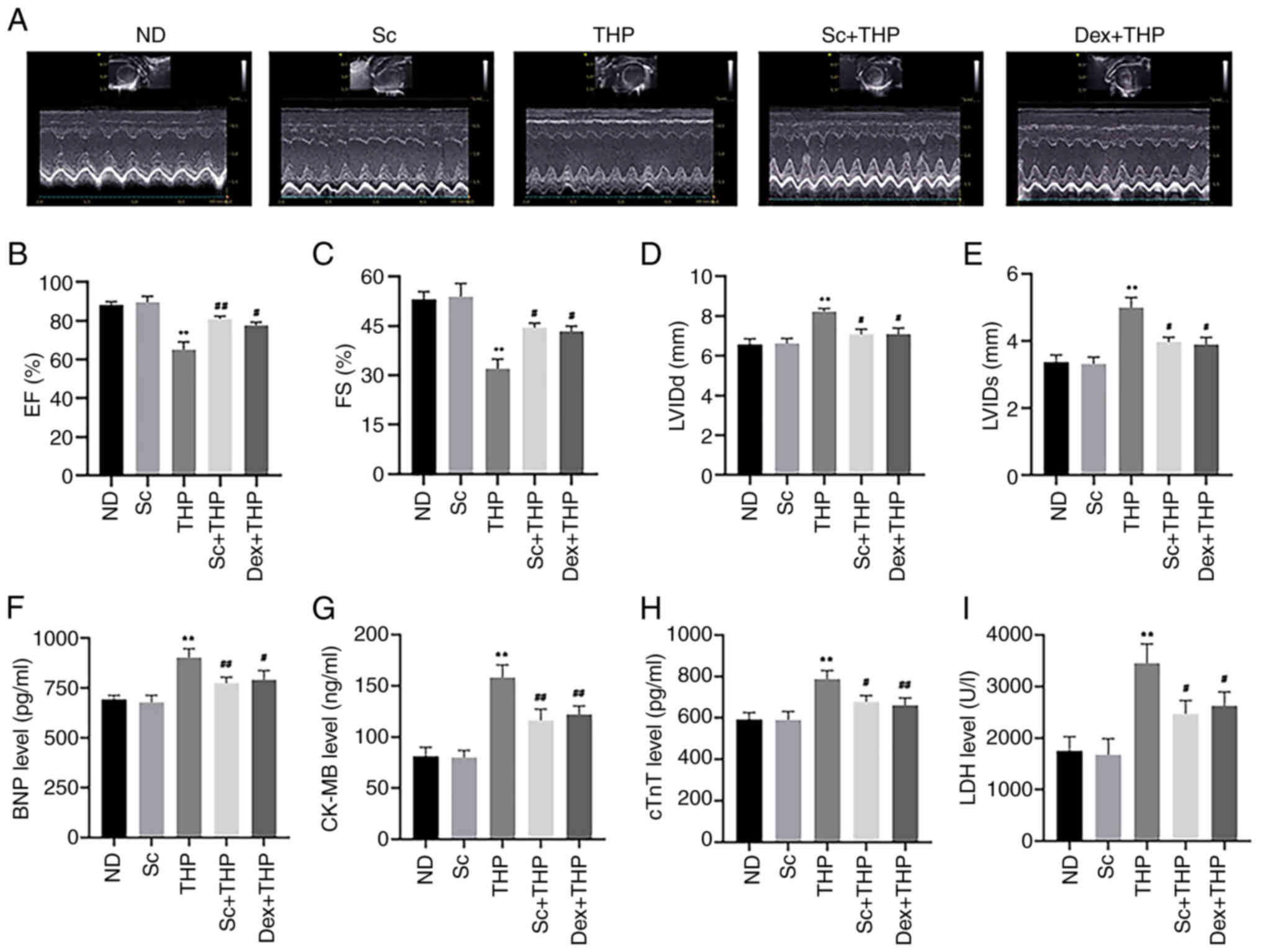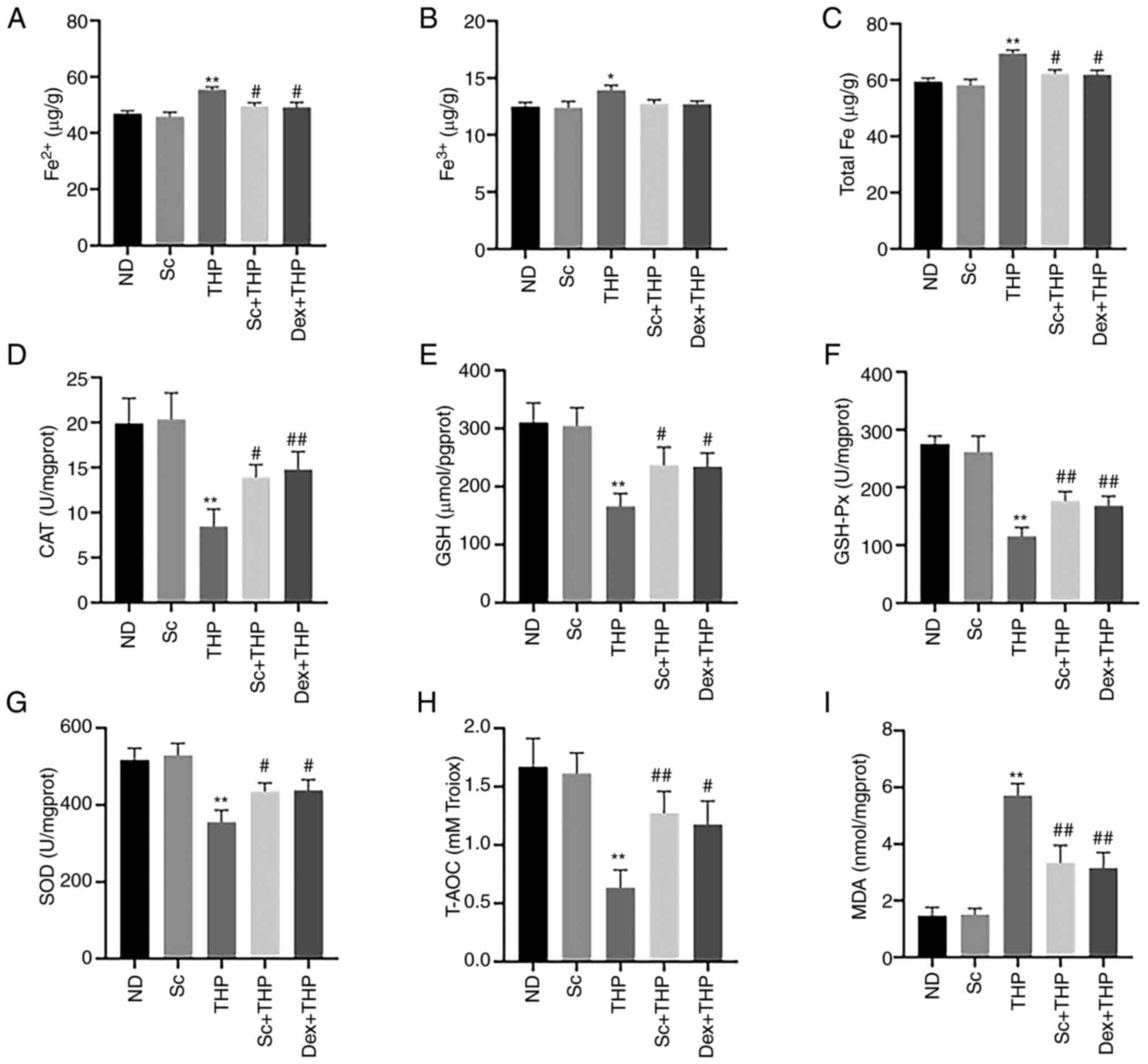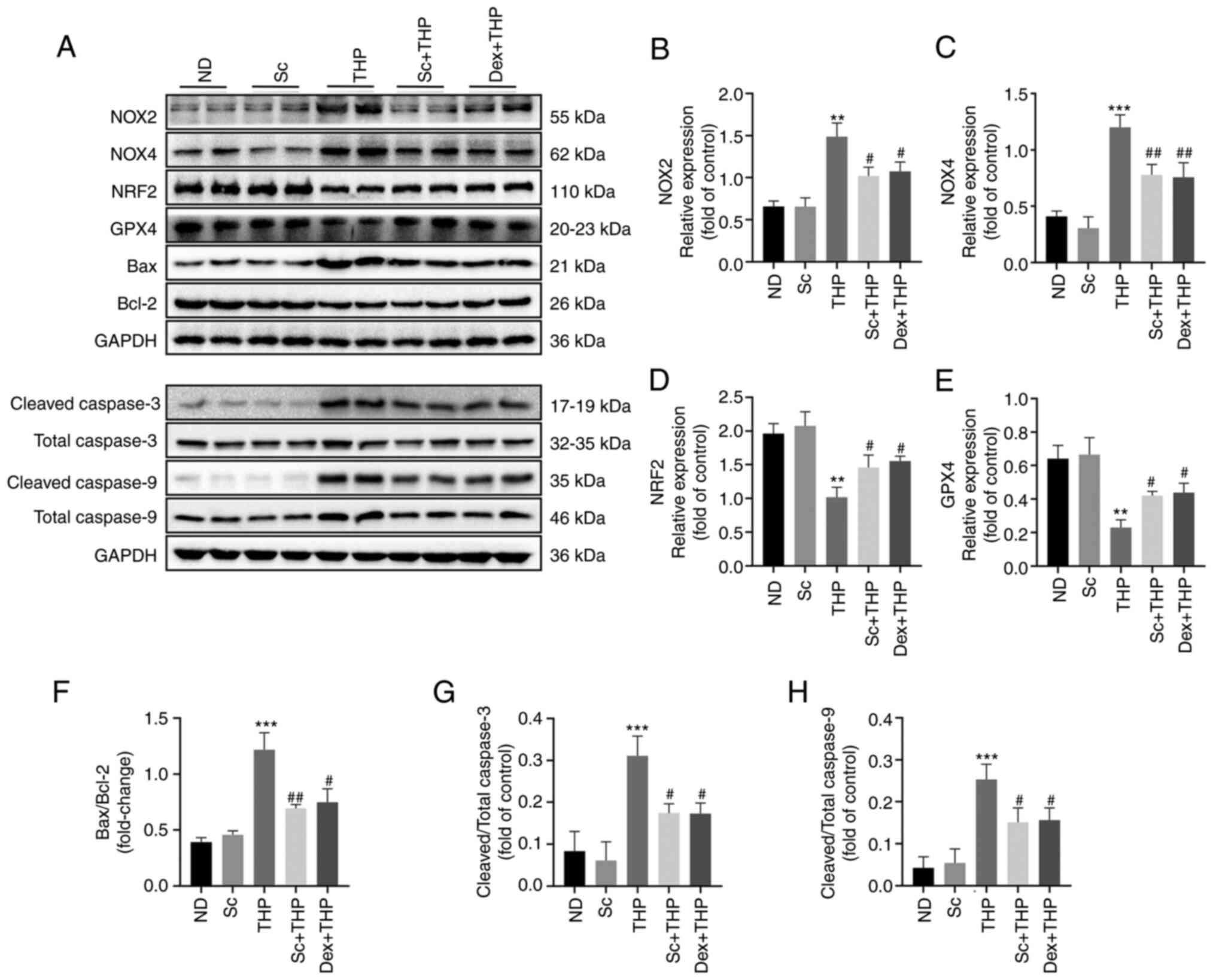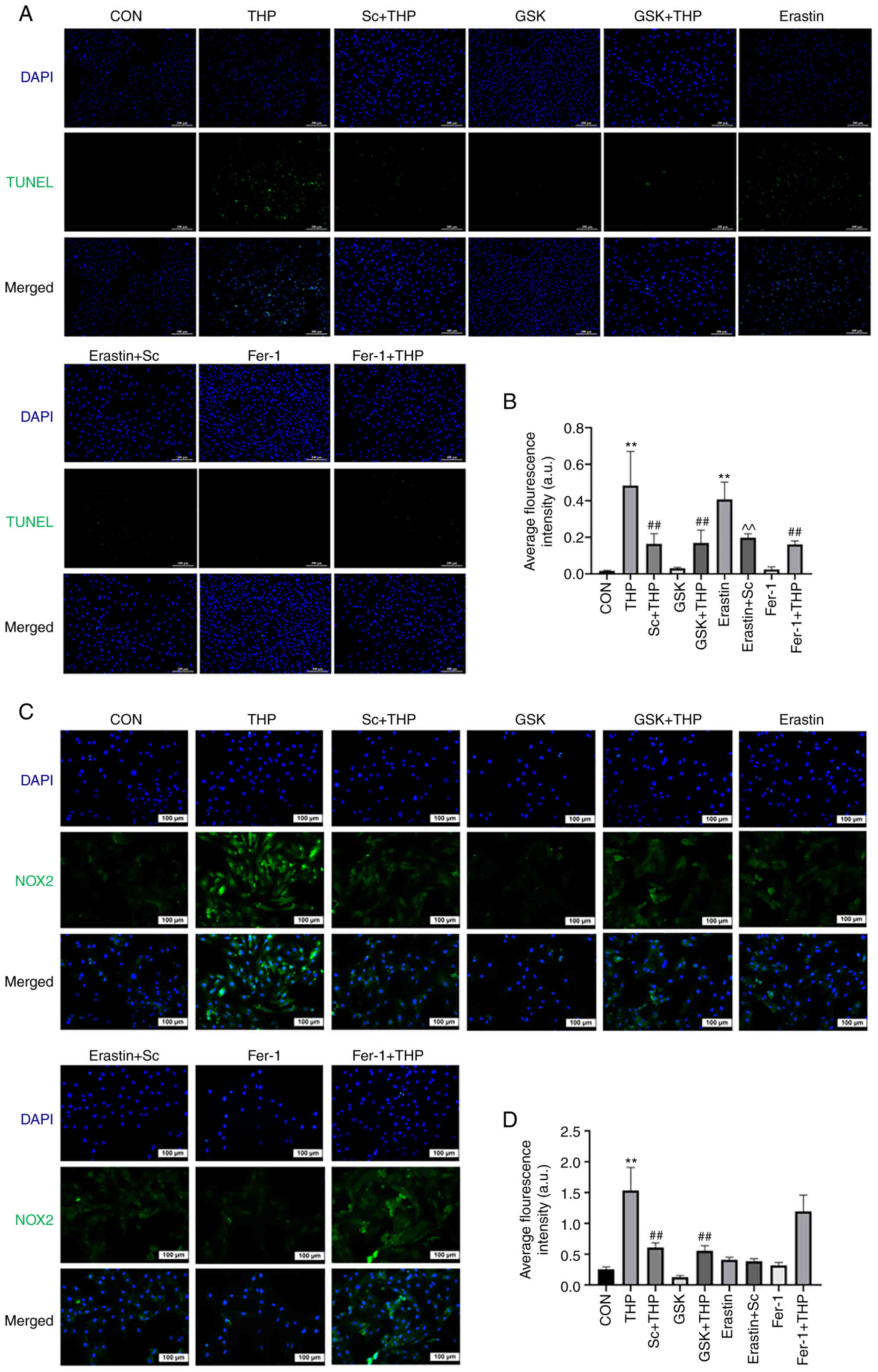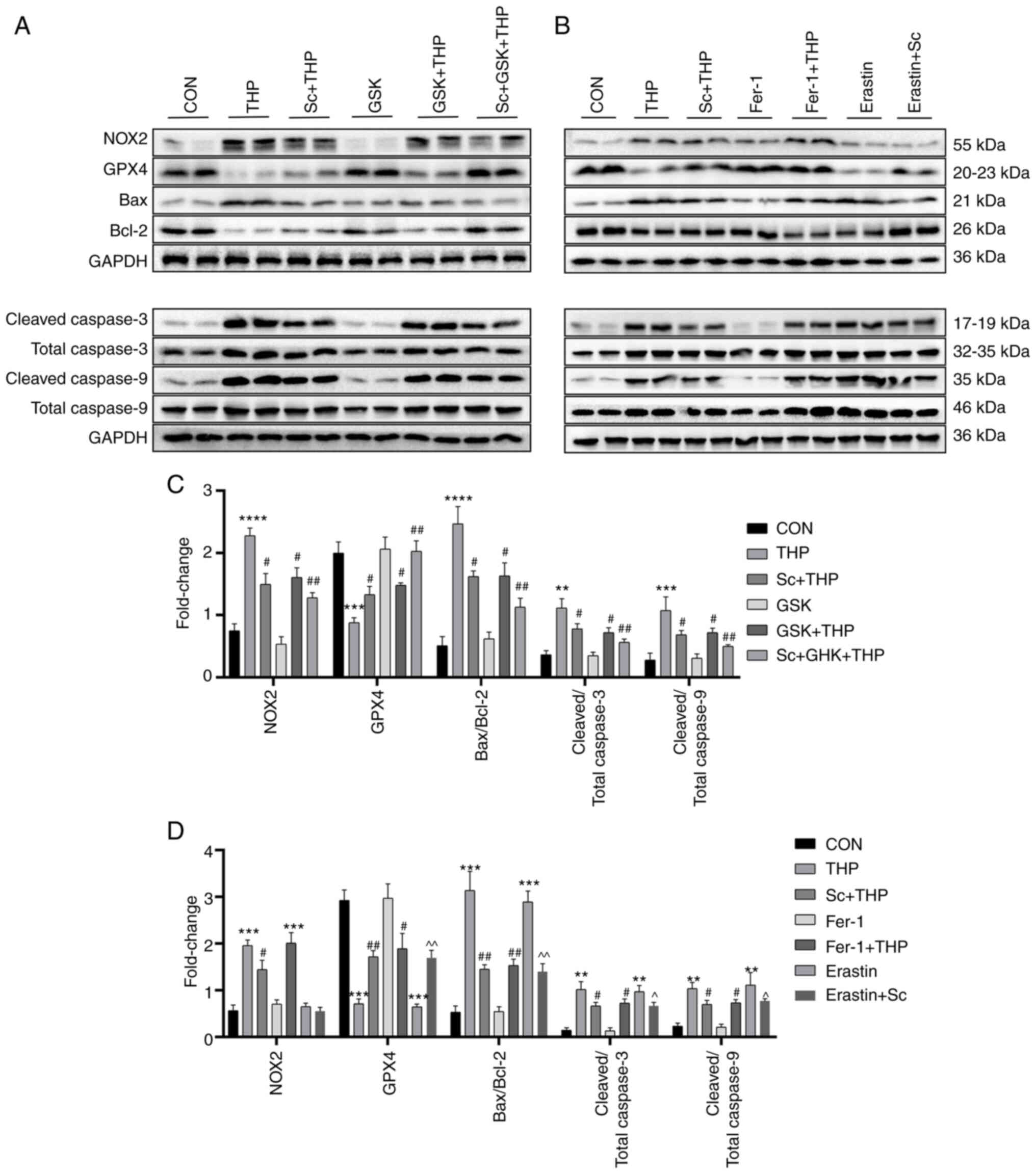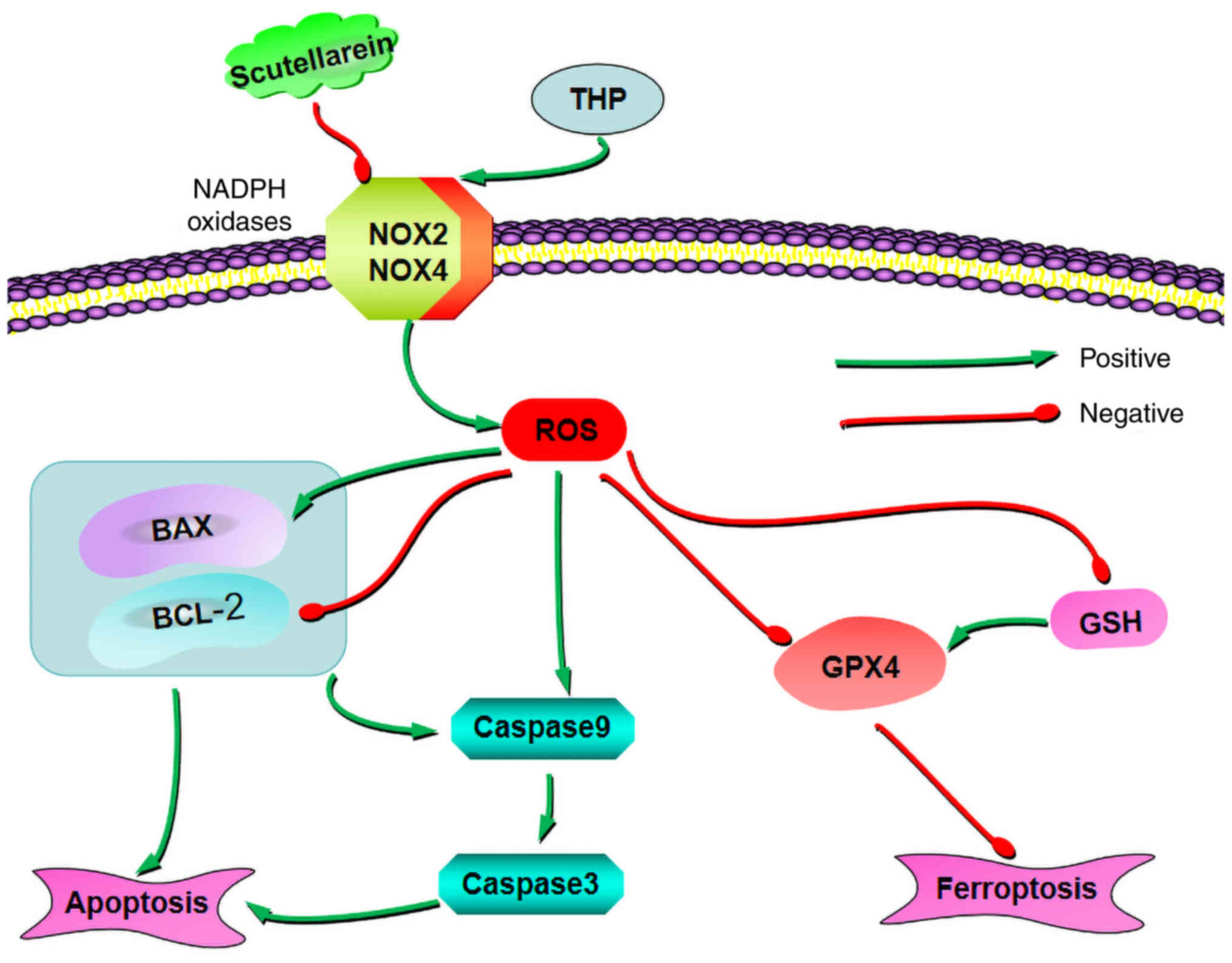Food therapy of scutellarein ameliorates pirarubicin‑induced cardiotoxicity in rats by inhibiting apoptosis and ferroptosis through regulation of NOX2‑induced oxidative stress
- Authors:
- Published online on: March 19, 2024 https://doi.org/10.3892/mmr.2024.13208
- Article Number: 84
-
Copyright: © Lan et al. This is an open access article distributed under the terms of Creative Commons Attribution License.
Abstract
Introduction
Currently, malignant tumors seriously endanger human life and health. Chemotherapy is considered as the most significant treatment strategy against cancer (1–4). Pirarubicin (THP) is a common chemotherapeutic drug used clinically. However, due to its cardiotoxicity, its clinical application remains limited (5–8).
It has been reported that cardiotoxicity caused by pirarubicin (CTP) is closely associated with the occurrence of oxidative stress in cardiomyocytes (9–11). Reactive oxygen species (ROS), the key intermediate of oxidative stress, plays a significant role in CTP (12,13). NADPH oxidases (NOXs), a major intracellular enzymatic source of ROS, are transmembrane complexes with electron-transferring ability that produce ROS (14,15). NOX2 is abundantly expressed in cardiomyocytes (16,17). A previous study demonstrated that increased ROS levels promoted mitochondrial dysfunction and it was therefore considered as a significant factor in mitochondria-mediated apoptosis (18). In addition, enhanced ROS levels have also been associated with lipid peroxidation, which in turn promotes the onset of a unique cell death mode, namely ferroptosis (19).
Scutellarein (Sc), a flavone monomer with known anti-inflammatory and antioxidant properties, is widely used in food and medical products (20–22). Previous studies demonstrated that Sc could improve oxidative stress in a diabetes mouse model and superoxide-induced rat cortical synaptosomes (23,24). Based on the aforementioned findings, it was hypothesized that food therapy with Sc ameliorated CTP via inhibition of apoptosis and ferroptosis through regulation of oxidative stress. However, this hypothesis has not been confirmed in in vivo or in vitro studies, while the effect of Sc on NOX2 remains largely unknown.
The present study aimed to explore the anti-oxidative stress, anti-ferroptosis and anti-apoptotic properties of Sc and the effects of the Sc-related key pathways on regulating oxidative stress, apoptosis and ferroptosis in CTP.
Materials and methods
Materials
The H9c2 cardiomyocyte cell line (cat. no. ZQ0102) was provided by Shanghai Zhongqiao Xinzhou Biotechnology Co., Ltd. THP, Sc, dexrazoxane (Dex; a drug particularly approved by the US Food and Drug Administration for the treatment of CTP), GSK2795039 (GSK), ferrostatin-1 (Fer-1) and erastin were purchased from MedChemExpress. The brain natriuretic peptide (BNP, cat. no. H166-1-2), creatine kinase MB (CK-MB, cat. no. H197-1-1) and cardiac troponin T (cTnT, cat. no. H149-4-2) kits were purchased from Nanjing Jiancheng Bioengineering Institute. Cell Counting Kit-8 (CCK-8), ROS (cat. no. S0033M) and TUNEL (cat. no. C10088) apoptosis assay kits were purchased from Beyotime Institute of Biotechnology. DMEM and FBS were obtained from Gibco (Thermo Fisher Scientific, Inc.) and BioAgrio, respectively. The reduced glutathione (GSH, cat. no. A006-2-1), glutathione peroxidase (GSH-Px, cat. no. A005-1-2), catalase (CAT, cat. no. A007-1-1), malondialdehyde (MDA, cat. no. A003-1-2), superoxide dismutase (SOD, cat. no. A001-3-2), lactate dehydrogenase (LDH, cat. no. A020-2-2) and total antioxidant capacity (T-AOC, cat. no. A015-2-1) assay kits were obtained from Nanjing Jiancheng Bioengineering Institute. An iron assay kit (, cat. no. ab83366) was purchased from Abcam, while the antibodies against glutathione peroxidase 4 (GPX4), NOX2, NOX4, erythroid 2-related factor 2 (NRF2), Bax, Bcl-2, GAPDH, caspase 3 and caspase 9 from Proteintech Group, Inc.
Animal studies
Animal model and diet
In the present study, a total of 50 male Sprague-Dawley (SD) rats (weight, 180–200 g) were obtained from the Experimental Animal Center of Chongqing Medical University. Rats were maintained under specific pathogen-free conditions at 23±2°C, 55±5% relative humidity, a 12-h light/dark cycle and had free access to food and water. The rats were randomly divided into the following five groups (n=10 rats/group): i) The normal diet group (ND), where rats were fed standard chow and injected with an equal volume of normal saline via the tail vein, once a week for eight weeks; ii) the Sc group (Sc), where rats were fed with Sc feed (100 mg/kg) and injected with an equal volume of normal saline via the tail vein, once a week for eight weeks; iii) the THP group (THP), where rats were fed with standard chow, while 3 mg/kg THP was injected into the tail vein once a week for eight weeks (25); iv) the Sc + THP group (Sc + THP), were rats were fed with Sc feed (100 mg/kg) and 3 mg/kg THP was injected into the tail vein once a week for eight weeks; and v) the Dex + THP group (Dex + THP), where rats were fed with standard chow, while 3 mg/kg THP and 30 mg/kg Dex was injected into the tail vein and abdominal cavity, respectively, once a week for eight weeks. The survival of rats was recorded every day, while food consumption and rat weight were recorded once a week.
Echocardiography
The experiment was completed at week 8. Rats were first anesthetized by isoflurane inhalation (2% for induction and 2% for maintenance). Subsequently, after removing the chest hair of rats, the VIVID E95 and L8-18I-D probes (General Electric Company) were used to perform doppler echocardiography to measure ejection fraction (EF), fractional shortening (FS), left ventricular end-diastolic diameter (LVIDd) and left ventricular end-systolic diameter (LVIDs).
Sample collection, preparation and biochemical analysis
Following overnight fasting, rats were weighed and euthanized by cervical dislocation following anesthesia with 1% pentobarbital (40 mg/kg). Rat hearts were then removed, weighed and stored at −80°C until further use. A part of the heart tissues was homogenized and the levels of iron, GSH, GSH-Px, MDA, SOD and T-AOC were immediately measured, according to the manufacturer's instructions. Within 2 h, blood samples were collected from the abdominal aorta and centrifuged at 900 × g for 30 min at room temperature. The supernatant was then stored at −80°C. The serum levels of LDH, BNP, CK-MB and cTnT were directly determined using the corresponding kits.
Cell studies
Cell culture, treatment and grouping
H9c2 cells were cultured in DMEM supplemented with 10% (v/v) FBS in a humidified incubator with 95% air and 5% CO2 at 37°C. To establish an in vitro injury model, H9c2 cells were treated with 5 µmol/l THP for 24 h. Subsequently, to evaluate the association between oxidative stress, ferroptosis and apoptosis in CTP, the in vitro experiments were carried out into two parts. Therefore, cells were grouped as follows: a) Direction of oxidative stress, including i) the control (CON) group, where cells were cultured in DMEM; ii) the THP group (THP), where cells were treated with 5 µmol/l THP for 24 h; iii) the Sc + THP group (Sc + THP), where cells were pretreated with 100 µmol/l Sc for 1 h followed by treatment with 5 µmol/l THP for 24 h; iv) the GSK group (GSK), where cells were treated with 25 µmol/l GSK for 24 h (26); v) the GSK + THP group (GSK + THP), where cells were co-treated with 5 µmol/l THP and 25 µmol/l GSK for 24 h; and vi) the Sc + GSK + THP group (Sc + GSK + THP), where cells were pretreated with 100 µmol/l Sc for 1 h followed by co-treatment with 5 µmol/l THP and 25 µmol/l GSK for 24 h. b) Direction of ferroptosis, including i) the CON group (CON), where cells were cultured in DMEM; ii) the THP group (THP), where cells were treated with 5 µmol/l THP for 24 h; iii) the Sc + THP group (Sc + THP), where cells were pretreated with 100 µmol/l Sc for 1 h, followed by treatment with 5 µmol/l THP for 24 h; iv) the Fer-1 group, where cells were treated with 10 µmol/l Fer-1 for 24 h (27); v) the Fer-1 + THP group (Fer-1 + THP), where cells were co-treated with 10 µmol/l Fer-1 and 5 µmol/l THP for 24 h; vi) the erastin group (erastin), where cells were treated with 5 µmol/l erastin for 24 h (28); and the erastin + Sc group (erastin + Sc), where cells were pretreated with 100 µmol/l Sc for 1 h, followed by co-treatment with 5 µmol/l erastin for an additional 24 h.
Cell viability assay
H9c2 cells were seeded in 96-well plates at a density of 5×103 cells/well for 12 h, prior to use. Following treatment, a CCK-8 assay kit was used to evaluate cell viability. Briefly, cells in each well were supplemented with 10 µl CCK-8 reagent followed by incubation for 2 h. Subsequently, the absorbance in each well was measured at a wavelength of 450 nm using a single-wavelength microplate reader.
ROS staining
Cells were seeded into 24-well plates and after reaching 50–60% confluency, they were treated with the indicated compounds. Subsequently, cells were stained with DCFH-DA dye (37°C, 20 min), provided by the ROS kit, according to the manufacturer's instructions (Beyotime Institute of Biotechnology). Cells were observed under a fluorescence microscope and the positive stained area was measured using ImageJ v1.53c software (National Institutes of Health).
Cell apoptosis
For cell apoptosis assessment, cells were seeded into 24-well plates and after reaching 50–60% confluency, the cells were treated as previously described. Subsequently, cell apoptosis was assessed using a TUNEL apoptosis assay kit, according to the manufacturer's instructions. Briefly, following fixing at room temperature for 30 min (Immunostaining fixative, Beyotime Institute of Biotechnology, cat. no. P0098), H9c2 cells were washed with ice-cold PBS and stained with DAPI (at room temperature for 5 min, Beyotime Institute of Biotechnology, cat. no. C1005) and TUNEL dyes (protected from light, at 37°C for 60 min). After washing, fluorescent images were captured under a fluorescence microscope and analyzed using ImageJ v1.53c software.
Immunofluorescence staining
Cells were fixed with 4% formaldehyde (at room temperature for 15 min), washed with PBS and were then permeabilized with 0.2% Triton X-100 (at room temperature for 20 min). Following blocking with goat serum (cat. no. C0265; Beyotime Institute of Biotechnology) at room temperature for 30 min, the cells were first incubated at 4°C, overnight with primary antibodies against NOX2 (cat. no. 19013-1-AP; 1:200; Proteintech Group, Inc.) and then with the corresponding secondary antibody [FITC-labeled goat anti-rabbit IgG (H+L); cat. no. A0562; 1:500; Beyotime Institute of Biotechnology] at room temperature for 90 min. Finally, the cell nuclei were stained with DAPI (at room temperature for 5 min) and images were captured under a fluorescence microscope.
Western blot analysis
The protein expression levels of GAPDH (cat. no. 10494-1-AP; 1:5,000), NOX2 (cat. no. 19013-1-AP; 1:1,000), NOX4 (cat. no. 14347-1-AP; 1:1,000), NRF2 (cat. no. 16396-1-AP; 1:2,000), GPX4 (cat. no. 30388-1-AP; 1:500), Bax (cat. no. 50599-2-Ig; 1:2,000), Bcl-2 (cat. no. 26593-1-AP; 1:500), cleaved and total caspase 3 (cat. no. 19677-1-AP; 1:500), and cleaved and total caspase 9 (cat. no. 10380-1-AP; 1:500) were detected by western blot analysis. Briefly, H9c2 cells or cardiac tissue were lysed in RIPA lysis buffer (Beyotime Institute of Biotechnology) with 1% (v/v) phenylmethylsulfonyl fluoride. Following centrifugation at 13,700 × g for 15 min at 4°C, the supernatants were collected and then the protein concentration was measured using a BCA protein determination kit. An equal amount of protein extracts (30 µg) was separated by 12% SDS-PAGE and proteins were then transferred onto a PVDF membrane. Following blocking with 5% (w/v) skimmed milk (at room temperature for 2 h), the membrane was cut into strips according to the molecular weight of each target-protein. Subsequently, the membrane was first incubated with primary antibodies overnight at 4°C and then with the corresponding horseradish peroxidase-conjugated secondary antibodies (cat. no. SA00001-2; Proteintech Group, Inc.; 1:5,000). The protein bands were visualized using an ECL reagent (Biosharp life sciences, cat. no. BL520B). GAPDH served as an internal control for protein loading and analysis. ChemiDoc™ XRS+ with Image Lab Software (BIO-RAD) was used for densitometry.
Statistical analysis
GraphPad Prism 8.0 (Dotmatics) was used for statistical analysis. All experiments were repeated at least three times. The data are expressed as the mean ± standard deviation. First, the normal distribution and homogeneity of variance of the data were assessed. The differences between groups were compared using one- or two-way ANOVA, followed by Tukey's multiple comparison post hoc test. P<0.05 was considered to indicate a statistically significant difference.
Results
Sc effectively improves the THP-mediated changes in food intake, body weight, heart indexes and survival in SD rats
As shown in Fig. 1, compared with the ND group, food intake was significantly reduced from the third week in the THP group (THP vs. ND, P<0.01; Fig. 1B). In addition, rat weight was also notably decreased in the THP group at the fourth week compared with the ND group (THP vs. ND, P<0.01; Fig. 1A). After eight weeks, the survival rate of rats in the THP group was markedly reduced compared with the ND group (Fig. 1C), while the cardiac mass index was notably enhanced (THP vs. ND, P<0.01; Fig. 1D). However, co-treatment of rats with Sc and Dex significantly restored the aforementioned changes (Sc + THP vs. THP: P<0.05, cardiac mass index and P<0.01, body weight and food intake; Dex + THP vs. THP: P<0.05, cardiac mass index and P<0.01, body weight and food intake; Fig. 1A-D).
Sc effectively improves the THP-induced abnormal changes in myocardial injury markers and echocardiography in SD rats
As shown in Fig. 2, after treatment of SD rats with THP for eight weeks, significant changes were observed in the echocardiography parameters in the THP group compared with the ND group (Fig. 2A), including decreased EF and FS (THP vs. ND, P<0.01; Fig. 2B and C) and increased LVIDd and LVIDs (THP vs. ND, P<0.01; Fig. 2D and E). At the same time, abnormal levels of the myocardial injury-related markers, BNP, CK-MB, cTnT and LDH, were recorded in the THP group (THP vs. ND, P<0.01; Fig. 2F-I). However, the aforementioned changes were improved following treatment of SD rats with Sc and Dex (Sc + THP vs. THP, P<0.05 for FS, LVIDd, LVIDs, cTnT and LDH, and P<0.01 for EF, BNP, CK-MB; Dex + THP vs. THP, P<0.05 for EF, FS, LVIDd, LVIDs, BNP and LDH, and P<0.01 for CK-MB and cTnT; Fig. 2A-I).
Sc alleviates the THP-induced abnormal changes in the oxidative stress- and ferroptosis-related indexes in blood and myocardial tissues of SD rats. Compared with the ND group, Fe2+, Fe3+ and total Fe levels were enhanced in the THP group (THP vs. ND, P<0.05 for Fe3+ and P<0.01 for Fe2+ and total Fe; Fig. 3A-C), while this effect was restored by rat treatment with Sc and Dex (Sc + THP vs. THP, P<0.05 for Fe2+ and total Fe; Dex + THP vs. THP, P<0.05 for Fe2+ and total Fe; Fig. 3A and C). In addition, the levels of CAT, GSH, GSH-Px, SOD and T-AOC were reduced (THP vs. ND, P<0.01; Fig. 3D-H), while the level of MDA was increased (THP vs. ND, P<0.01; Fig. 3I) in the THP group compared with the ND group, and these effects were also restored following treatment of SD rats with Sc and Dex (Sc + THP vs. THP, P<0.05 for CAT, GSH and SOD, and P<0.01for GSH-Px, T-AOC and MDA; Dex + THP vs. THP, P<0.05 for GSH, SOD and T-AOC, and P<0.01 for CAT, GSH-Px and MDA; Fig. 3D-I).
Effects of Sc and THP on the expression of oxidative stress-, ferroptosis- and apoptosis-related proteins in the myocardium of SD rats. The results of western blot analysis showed that THP increased the expression of oxidative stress-related proteins, such as NOX2 and NOX4, and decreased those of NRF2, in the myocardial tissues of SD rats (THP vs. ND, P<0.01 for NOX2 and NRF2, and P<0.001 for NOX4; Fig. 4A-D). Additionally, THP downregulated GPX4, a ferroptosis-related protein (THP vs. ND, P<0.01; Fig. 4E). In terms of apoptosis, THP notably enhanced the Bax/Bcl-2 ratio, the cleaved caspase 3/total caspase 3 and cleaved caspase 9/total caspase 9 ratio (THP vs. ND, P<0.001 for Bax/Bcl-2, cleaved caspase 3/total caspase 3 and cleaved caspase 9/total caspase 9; Fig. 4A and F-H), while these were restored by Sc and Dex (Sc + THP vs. THP, P<0.05 for NOX2, NRF2, GPX4, cleaved caspase 3/total caspase 3 and cleaved caspase 9/total caspase 9, and P<0.01 for NOX4, Bax/Bcl-2; Dex + THP vs. THP, P<0.05 for NOX2, NRF2, GPX4, Bax/Bcl-2, cleaved caspase 3/total caspase 3 and cleaved caspase 9/total caspase 9, and P<0.01 for NOX4; Fig. 4B-H).
Sc ameliorates the THP-mediated decrease in H9c2 myocardial cell viability
In vitro experiments using CCK-8 assays, showed that 5 µmol/l THP and 100 µmol/l Sc were the optimal concentrations to treat cells (5 µmol/l THP vs. CON, P<0.001; 100 µmol/l Sc + THP vs. THP, P<0.01; Fig. 5A and B). CCK-8 assays showed that THP significantly reduced the viability of H9c2 cells, which was improved by cell treatment with Sc, GSK and Fer-1 (THP vs. CON, P<0.01; Sc + THP vs. THP, P<0.05; GSK + THP vs. THP, P<0.05; and Fer-1 + THP vs. THP, P<0.05; Fig. 5C-E). Furthermore, erastin had a similar effect with THP on cell viability, which was also alleviated by Sc (erastin vs. CON, P<0.01; and erastin + Sc vs. erastin, P<0.01; Fig. 5E).
Effects of Sc, THP, GSK, Fer-1 and erastin on ROS generation in H9c2 cardiomyocytes
As shown in Fig. 5D and F, THP enhanced ROS production in H9c2 cells, while Sc and GSK antagonized this effect (THP vs. CON, P<0.01; Sc + THP vs. THP, P<0.01; and GSK + THP vs. THP, P<0.01; Fig. 5F). Furthermore, erastin also increased ROS production in H9c2 cells, which was alleviated by Sc (erastin vs. CON, P<0.01; erastin + Sc vs. erastin, P<0.01; Fig. 5F). Consistently, Fer-1 also improved the THP-mediated increase in ROS production (Fer-1 + THP vs. THP, P<0.01; Fig. 5F).
Effects of Sc, THP, GSK, Fer-1 and erastin on H9c2 cardiomyocyte apoptosis
TUNEL staining results indicated that THP promoted H9c2 cell apoptosis (THP vs. CON, P<0.01; Fig. 6A and B). This effect was abrogated by cell treatment with GSK, Fer-1 and Sc (Sc + THP vs. THP, P<0.01; GSK + THP vs. THP, P<0.01; and Fer-1 + THP vs. THP, P<0.01; Fig. 6A and B). In addition, erastin also enhanced H9c2 cell apoptosis, which was also improved by Sc (erastin vs. CON, P<0.01; erastin + Sc vs. erastin, P<0.01; Fig. 6A and B).
Effects of Sc, THP, GSK, Fer-1 and erastin on the expression of oxidative stress-, ferroptosis- and apoptosis-related proteins in H9c2 cardiomyocytes. The in vitro immunofluorescence results shown in Fig. 6C and D, revealed that compared with the CON group, NOX2 was upregulated in the THP group (THP vs. CON, P<0.01; Fig. 6C and D). The protein expression levels of NOX2 were restored following cell treatment with Sc and GSK (Sc + THP vs. THP, P<0.01; and GSK + THP vs. THP, P<0.01; Fig. 6C and D). However, Fer-1 and erastin did not significantly affect NOX2 expression. Furthermore, the western blot results also demonstrated that THP markedly upregulated NOX2, increased the Bax/Bcl-2, cleaved caspase 3/total caspase 3, cleaved caspase 9/total caspase 9 ratio and downregulated GPX4 (THP vs. CON, P<0.01 for cleaved caspase 3/total caspase 3; P<0.001 for GPX4, cleaved caspase 9/total caspase 9; and P<0.0001 for NOX2 and Bax/Bcl-2; Fig. 7C). The aforementioned results were restored by cell treatment with Sc (Sc + THP vs. THP, P<0.05 for NOX2, GPX4, Bax/Bcl-2, cleaved caspase 3/total caspase 3 and cleaved caspase 9/total caspase 9; Fig. 7C). At the same time, the aforementioned effects were also improved by GSK treatment (GSK + THP vs. THP, P<0.05 for NOX2, GPX4, Bax/Bcl-2, cleaved caspase 3/total caspase 3 and cleaved caspase 9/total caspase 9; Fig. 7C). Consistent with the immunofluorescence results, erastin and Fer-1 had no effect on NOX2 expression (Fig. 7D). Notably, H9c2 cell treatment with erastin increased the Bax/Bcl-2 ratio, upregulated cleaved caspase 3/9, total caspase 3/9 and downregulated GPX4 (erastin vs. CON, P<0.01 for cleaved caspase 3/total caspase 3, cleaved caspase 9/total caspase 9; and P<0.001 for GPX4 and Bax/Bcl-2; Fig. 7D), while Sc improved some aforementioned effects (erastin + Sc vs. erastin, P<0.05 for cleaved caspase 3/total caspase 3 and cleaved caspase 9/total caspase 9; and P<0.01 for GPX4 and Bax/Bcl-2; Fig. 7D). In addition, Fer-1 improved aberrant protein effects in H9c2 cells induced by THP (Fer-1 + THP vs. THP, P<0.05 for GPX4, cleaved caspase 3/total caspase 3 and cleaved caspase 9/total caspase 9; and P<0.01 for Bax/Bcl-2; Fig. 7D).
Discussion
With the increasing incidence of malignant tumors, chemotherapy-induced myocardial toxicity has become a public health problem that cannot be ignored. CTP is considered as a significant component of the aforementioned problem (29,30). It has been reported that oxidative stress and ROS, a key product of oxidative stress, are closely associated with the onset of CTP in myocardial cells (8). Therefore, regulating oxidative stress can be a significant entry point for the prevention and treatment of CTP (31). In the present study, the results demonstrated that THP notably inhibited the growth of SD rats, reduced their survival rate and severely impaired cardiac function, as verified by the abnormal elevation of the myocardial injury-related markers, BNP, CK-MB, cTnT and LDH, and the changes in cardiac echocardiography. The aforementioned findings verified that THP could successfully induce myocardial toxicity in SD rats. In addition, THP promoted abnormal changes in oxidative stress-related indexes in the blood and myocardium of SD rats, thus further supporting that oxidative stress may play a significant role in THP-induced myocardial toxicity. Notably, the in vivo experiments also revealed that THP promoted aberrant changes in the expression of apoptosis-related indicators, such as Bax, Bcl-2, cleaved caspase 3 and cleaved caspase 9, and ferroptosis-related indicators, including Fe2+, total Fe and GPX4, in SD rats. Therefore, it was suggested that CTP may be associated with oxidative stress, ferroptosis and apoptosis.
Sc has strong antioxidant properties and is widely used in the medical and food industries (20–22). Therefore, herein, to explore the effect of Sc on CTP, SD rats were subjected to food therapy with Sc. Currently, oxidative stress is considered the central mechanism of anthracycline-induced myocardial toxicity (8,32). Different from other cells, myocardial cells have high energy demands and therefore are rich in mitochondria, where ROS-producing enzymes, such as NOX2, are located. Therefore, the majority of ROS is produced in mitochondria (33–35). When cells are induced, NOX2 is activated to produce ROS via delivering electrons from NADPH to oxygen through the transmembrane (36). Previous studies showed that anthracycline chemotherapeutic drugs aggravated oxidative stress in myocardial cells and promoted the production of ROS, thus suggesting that myocardial cells are vulnerable to anthracycline drugs (8,37). Consistent with the aforementioned finding, in the present study, treatment of myocardial cells with THP promoted oxidative stress and ROS overproduction. Furthermore, cell co-treatment with Sc improved the THP-mediated NOX2 upregulation, thus further improving the increase of ROS and alleviating the THP-induced oxidative stress.
Mitochondria are a significant regulatory target of apoptosis, while ROS is one of the triggering factors of mitochondrial-mediated apoptosis (38,39). Low levels of ROS are critical for cell proliferation, signal transduction and other physiological processes, while its enhanced levels are associated with cytotoxicity, which promotes DNA damage, mitochondrial dysfunction, reduced protein synthesis and destruction of intracellular calcium homeostasis, eventually leading to cardiomyocyte apoptosis (39–41). The results of the present study indicated that THP increased the expression of apoptosis-related proteins, namely Bax/Bcl-2, cleaved caspase 3 and cleaved caspase 9, in cardiomyocytes. However, treatment with Sc and GSK reversed these effects, thus suggesting that regulating oxidative stress could improve THP-induced cardiomyocyte apoptosis.
On the other hand, THP also promoted changes in the expression of the key ferroptosis-related protein, GPX4, thus supporting that in addition to oxidative stress and apoptosis, ferroptosis may be also involved in CTP. As aforementioned, THP induced oxidative stress and promoted ROS production in myocardial cells. A previous study showed that the excessive production of ROS induced lipid peroxidation, thus indicating that ferroptosis could be considered as a newly discovered unique method of cell death driven by iron-dependent lipid peroxidation (19). It has been reported that ferroptosis is regulated by several cellular metabolic pathways, such as iron homeostasis, redox homeostasis, mitochondrial activity and various disease-related signal transduction pathways (19,42,43). A previous study demonstrated that NOX4 promoted ferroptosis in astrocytes through oxidative stress-induced lipid peroxidation (44). GPX4, also known as phospholipid hydrogen glutathione peroxidase, prevented ferroptosis via converting lipid hydroperoxide into non-toxic lipid alcohols (42–44). Furthermore, astragaloside IV attenuated ferroptosis in myocardial cells via promoting the expression of GPX4 through activating the NRF2 signaling pathway and regulating oxidative stress (45).
In the present study, ferroptosis was induced and inhibited following cell treatment with erastin and Fer-1, respectively. Erastin is a ferroptosis inducer, which functions through ROS and iron-dependent signaling (46,47). A previous study showed that erastin inhibited voltage-dependent anion channels 2/3 and accelerated oxidation, thus leading to the endogenous accumulation of ROS, which in turn induced lipid peroxidation, ultimately promoting ferroptosis (48,49). Additionally, Fer-1, as a radical-trapping antioxidant, attenuated the accumulation of lipid hydroperoxides via a reduction mechanism, thereby inhibiting ferroptosis (50,51). Notably, in addition to ferroptosis the effects of erastin and Fer-1 were also explored on apoptosis through in vitro experiments. The in vitro experiments indicated that erastin promoted apoptosis of H9c2 cells, while Fer-1 reduced myocardial cell apoptosis induced by THP. In addition, erastin promoted the expression of apoptosis-related proteins in H9c2 cells (Bax/Bcl-2 and cleaved caspase 3), while Fer-1 improved the aberrant expression of apoptosis-related proteins induced by THP. In addition, research has shown that erastin-induced increases in Bax and cytochrome c levels were counteracted by ferrostatin-1 pretreatment (52). It was therefore hypothesized that the effects on apoptosis may be associated with the mechanisms of erastin and Fer-1 on regulating ferroptosis via intensifying/inhibiting oxidative stress. Of note, the findings of the present study indicated that the regulation of erastin and Fer-1 for oxidative stress appeared to be independent of NOX2. As aforementioned, oxidative stress is closely associated with apoptosis, and the results revealed that THP downregulated GPX4, thus indicating that THP promoted ferroptosis in myocardial cells. In addition, GSK improved the THP-induced reduction of GPX4 expression, while Sc improved the erastin- and THP-mediated GPX4 downregulation. Furthermore, the combined treatment of myocardial cells with Sc and GSK further improved the THP-mediated reduction of GPX4 expression. The aforementioned findings indicated that regulation of oxidative stress improved the THP-induced ferroptosis in myocardial cells.
The toxic effect of anthracycline drugs on myocardium cannot be ignored, since it is a major public health problem that needs to be urgently solved. Herein, in vivo studies demonstrated that CTP was closely associated with oxidative stress, apoptosis and ferroptosis. Therefore, improving CTP via regulation of oxidative stress to inhibit myocardial cell apoptosis and ferroptosis appears to be a feasible strategy. Further experiments verified that food therapy with Sc inhibited cardiomyocyte apoptosis and ferroptosis via regulation of oxidative stress, thereby improving CTP. The aforementioned findings may provide novel insights into the clinical application of Sc and a significant theoretical basis for the implementation of Sc or even all anthracycline antineoplastic drugs in preventing and treating THP-induced cardiotoxicity.
However, the present study has some limitations. Although the current study investigated the protective effect of Sc on THP-induced myocardial injury and its association with oxidative stress, apoptosis and ferroptosis based on existing literature, its specific underlying mechanism remains unclear. In addition, the in vivo molecular mechanism underlying the protective effect of Sc on CTP was not explored. Furthermore, clinical trials on the effectiveness of Sc are still lacking. Therefore, further studies and clinical trials on this subject should be carried out in the future.
In conclusion, the present study indicated that Sc had antioxidant, anti-apoptotic, and anti-ferroptosis effects in CTP. In addition, the results suggested that Sc could further inhibit cell apoptosis and ferroptosis via negatively regulating the oxidative stress-related axis, NOX2/ROS, thereby improving the THP-induced cardiotoxicity (Fig. 8).
Acknowledgements
Not applicable.
Funding
This study was supported by the National Key R&D Program of China (grant nos. 2018YFC1311400 and 2018YFC1311404).
Availability of data and materials
The data generated in the present study are not publicly available due the fact that elements of the current basic and clinical research remain uncompleted and ongoing, and as a patent application will be filed. However, data may be requested from the corresponding author.
Authors' contributions
YL and FT confirm the authenticity of all the raw data. YL and FT performed the experiments. HT and PP analyzed and interpreted the data. QH and LD verified the results. YL and FT wrote the manuscript. QH and LD contributed to the conception, design and supervision of the study. All authors reviewed and approved the final version of the manuscript.
Ethics approval and consent to participate
This study was approved by the Animal Ethics Committee of the First Affiliated Hospital of Chongqing Medical University (approval no. IACUC-CQMU-2022-0127, Chongqing, China).
Patient consent for publication
Not applicable.
Competing interests
The authors declare that they have no competing interests.
References
|
Mullard A: Addressing cancer's grand challenges. Nat Rev Drug Discov. 19:825–826. 2020. View Article : Google Scholar : PubMed/NCBI | |
|
Hait WN: Anticancer drug development: The grand challenges. Nat Rev Drug Discov. 9:253–254. 2010. View Article : Google Scholar : PubMed/NCBI | |
|
von Minckwitz G and Loibl S: Evolution of adjuvant chemotherapy for breast cancer. Lancet. 385:1812–1814. 2015. View Article : Google Scholar : PubMed/NCBI | |
|
Shen SJ and Liu CM: Chemotherapy for early-stage breast cancer: The more the better? Lancet. 401:1243–1245. 2023. View Article : Google Scholar : PubMed/NCBI | |
|
Gabizon AA, Patil Y and La-Beck NM: New insights and evolving role of pegylated liposomal doxorubicin in cancer therapy. Drug Resist Updat. 29:90–106. 2016. View Article : Google Scholar : PubMed/NCBI | |
|
Pugazhendhi A, Edison TNJI, Velmurugan BK, Jacob JA and Karuppusamy I: Toxicity of Doxorubicin (Dox) to different experimental organ systems. Life Sci. 200:26–30. 2018. View Article : Google Scholar : PubMed/NCBI | |
|
Yu J, Wang C, Kong Q, Wu X, Lu JJ and Chen X: Recent progress in doxorubicin-induced cardiotoxicity and protective potential of natural products. Phytomedicine. 40:125–139. 2018. View Article : Google Scholar : PubMed/NCBI | |
|
Kong CY, Guo Z, Song P, Zhang X, Yuan YP, Teng T, Yan L and Tang QZ: Underlying the mechanisms of doxorubicin-induced acute cardiotoxicity: Oxidative stress and cell death. Int J Biol Sci. 18:760–770. 2022. View Article : Google Scholar : PubMed/NCBI | |
|
Tocchetti CG, Carpi A, Coppola C, Quintavalle C, Rea D, Campesan M, Arcari A, Piscopo G, Cipresso C, Monti MG, et al: Ranolazine protects from doxorubicin-induced oxidative stress and cardiac dysfunction. Eur J Heart Fail. 16:358–366. 2014. View Article : Google Scholar : PubMed/NCBI | |
|
Zhao L, Tao X, Qi Y, Xu L, Yin L and Peng J: Protective effect of dioscin against doxorubicin-induced cardiotoxicity via adjusting microRNA-140-5p-mediated myocardial oxidative stress. Redox Biol. 16:189–198. 2018. View Article : Google Scholar : PubMed/NCBI | |
|
McLaughlin D, Zhao Y, O'Neill KM, Edgar KS, Dunne PD, Kearney AM, Grieve DJ and McDermott BJ: Signalling mechanisms underlying doxorubicin and Nox2 NADPH oxidase-induced cardiomyopathy: Involvement of mitofusin-2. Br J Pharmacol. 174:3677–3695. 2017. View Article : Google Scholar : PubMed/NCBI | |
|
Li Q, Qin M, Tan Q, Li T, Gu Z, Huang P and Ren L: MicroRNA-129-1-3p protects cardiomyocytes from pirarubicin-induced apoptosis by down-regulating the GRIN2D-mediated Ca2+ signalling pathway. J Cell Mol Med. 24:2260–2271. 2020. View Article : Google Scholar : PubMed/NCBI | |
|
Han D, Wang Y, Wang Y, Dai X, Zhou T, Chen J, Tao B, Zhang J and Cao F: The tumor-suppressive human circular RNA CircITCH sponges miR-330-5p to ameliorate doxorubicin-induced cardiotoxicity through upregulating SIRT6, survivin, and SERCA2a. Circ Res. 127:e108–e125. 2020. View Article : Google Scholar : PubMed/NCBI | |
|
Chen YH, Chen ZW, Li HM, Yan XF and Feng B: AGE/RAGE-Induced EMP release via the NOX-Derived ROS pathway. J Diabetes Res. 2018:68230582018. View Article : Google Scholar : PubMed/NCBI | |
|
Zhang J, Wang X, Vikash V, Ye Q, Wu D, Liu Y and Dong W: ROS and ROS-Mediated cellular signaling. Oxid Med Cell Longev. 2016:43509652016. View Article : Google Scholar : PubMed/NCBI | |
|
Drummond GR and Sobey CG: Endothelial NADPH oxidases: Which NOX to target in vascular disease? Trends Endocrinol Metab. 25:452–463. 2014. View Article : Google Scholar : PubMed/NCBI | |
|
Prosser BL, Ward CW and Lederer WJ: X-ROS signaling: Rapid mechano-chemo transduction in heart. Science. 333:1440–1445. 2011. View Article : Google Scholar : PubMed/NCBI | |
|
Orrenius S, Gogvadze V and Zhivotovsky B: Mitochondrial oxidative stress: Implications for cell death. Annu Rev Pharmacol Toxicol. 47:143–183. 2007. View Article : Google Scholar : PubMed/NCBI | |
|
Stockwell BR: Ferroptosis turns 10: Emerging mechanisms, physiological functions, and therapeutic applications. Cell. 185:2401–2421. 2022. View Article : Google Scholar : PubMed/NCBI | |
|
Spiegel M, Marino T, Prejanò M and Russo N: On the scavenging ability of scutellarein against the OOH radical in water and Lipid-like environments: A Theoretical study. Antioxidants (Basel). 11:2242022. View Article : Google Scholar : PubMed/NCBI | |
|
Lin Y, Lin Y, Ren N, Li S, Chen M and Pu P: Novel anti-obesity effect of scutellarein and potential underlying mechanism of actions. Biomed Pharmacother. 117:1090422019. View Article : Google Scholar : PubMed/NCBI | |
|
Chagas MDSS, Behrens MD, Moragas-Tellis CJ, Penedo GXM, Silva AR and Gonçalves-de-Albuquerque CF: Flavonols and flavones as potential anti-inflammatory, antioxidant, and antibacterial compounds. Oxid Med Cell Longev. 2022:99667502022. View Article : Google Scholar : PubMed/NCBI | |
|
Gao L, Tang H, Zeng Q, Tang T, Chen M and Pu P: The anti-insulin resistance effect of scutellarin may be related to antioxidant stress and AMPKα activation in diabetic mice. Obes Res Clin Pract. 14:368–374. 2020. View Article : Google Scholar : PubMed/NCBI | |
|
Mei X, Zhang T, Ouyang H, Lu B, Wang Z and Ji L: Scutellarin alleviates blood-retina-barrier oxidative stress injury initiated by activated microglia cells during the development of diabetic retinopathy. Biochem Pharmacol. 159:82–95. 2019. View Article : Google Scholar : PubMed/NCBI | |
|
Shi H, Tang H, Ai W, Zeng Q, Yang H, Zhu F, Wei Y, Feng R, Wen L, Pu P and He Q: Schisandrin B antagonizes cardiotoxicity induced by pirarubicin by inhibiting mitochondrial permeability transition pore (mPTP) opening and decreasing cardiomyocyte apoptosis. Front Pharmacol. 12:7338052021. View Article : Google Scholar : PubMed/NCBI | |
|
Chai Y, Cao Z, Yu R, Liu Y, Yuan D and Lei L: Dexmedetomidine attenuates LPS-Induced Monocyte-Endothelial adherence via inhibiting Cx43/PKC-α/NOX2/ROS signaling pathway in monocytes. Oxid Med Cell Longev. 2020:29304632020. View Article : Google Scholar : PubMed/NCBI | |
|
Zhang H, Wang Z, Liu Z, Du K and Lu X: Protective effects of dexazoxane on rat ferroptosis in Doxorubicin-Induced cardiomyopathy through regulating HMGB1. Front Cardiovasc Med. 8:6854342021. View Article : Google Scholar : PubMed/NCBI | |
|
Li S, Lei Z, Yang X, Zhao M, Hou Y, Wang D, Tang S, Li J and Yu J: Propofol protects myocardium from ischemia/reperfusion injury by inhibiting ferroptosis through the AKT/p53 signaling pathway. Front Pharmacol. 13:8414102022. View Article : Google Scholar : PubMed/NCBI | |
|
Lim GB: Circular RNA prevents doxorubicin-induced cardiotoxicity. Nat Rev Cardiol. 19:5742022. View Article : Google Scholar : PubMed/NCBI | |
|
Gianni L, Herman EH, Lipshultz SE, Minotti G, Sarvazyan N and Sawyer DB: Anthracycline cardiotoxicity: From bench to bedside. J Clin Oncol. 26:3777–3784. 2008. View Article : Google Scholar : PubMed/NCBI | |
|
Han XZ, Gao S, Cheng YN, Sun YZ, Liu W, Tang LL and Ren DM: Protective effect of naringenin-7-O-glucoside against oxidative stress induced by doxorubicin in H9c2 cardiomyocytes. Biosci Trends. 6:19–25. 2012.PubMed/NCBI | |
|
Alanazi AM, Fadda L, Alhusaini A, Ahmad R, Hasan IH and Mahmoud AM: Liposomal resveratrol and/or carvedilol attenuate doxorubicin-induced cardiotoxicity by modulating inflammation, oxidative stress and S100A1 in rats. Antioxidants (Basel). 9:1592020. View Article : Google Scholar : PubMed/NCBI | |
|
Rosca MG and Hoppel CL: Mitochondria in heart failure. Cardiovasc Res. 88:40–50. 2010. View Article : Google Scholar : PubMed/NCBI | |
|
Hausenloy DJ and Ruiz-Meana M: Not just the powerhouse of the cell: Emerging roles for mitochondria in the heart. Cardiovasc Res. 88:5–6. 2010. View Article : Google Scholar : PubMed/NCBI | |
|
ChenY R and Zweier JL: Cardiac mitochondria and reactive oxygen species generation. Circ Res. 114:524–537. 2014. View Article : Google Scholar : PubMed/NCBI | |
|
Bedard K and Krause KH: The NOX family of ROS-generating NADPH oxidases: physiology and pathophysiology. Physiol Rev. 87:245–313. 2007. View Article : Google Scholar : PubMed/NCBI | |
|
Li D, Yang Y, Wang S, He X, Liu M, Bai B, Tian C, Sun R, Yu T and Chu X: Role of acetylation in doxorubicin-induced cardiotoxicity. Redox Biol. 46:1020892021. View Article : Google Scholar : PubMed/NCBI | |
|
D'Autreaux B and Toledano MB: ROS as signalling molecules: Mechanisms that generate specificity in ROS homeostasis. Nat Rev Mol Cell Biol. 8:813–824. 2007. View Article : Google Scholar : PubMed/NCBI | |
|
Stockwell BR: A powerful cell-protection system prevents cell death by ferroptosis. Nature. 575:597–598. 2019. View Article : Google Scholar : PubMed/NCBI | |
|
Tang D, Chen X, Kang R and Kroemer G: Ferroptosis: Molecular mechanisms and health implications. Cell Res. 31:107–125. 2021. View Article : Google Scholar : PubMed/NCBI | |
|
Park MW, Cha HW, Kim J, Kim JH, Yang H, Yoon S, Boonpraman N, Yi SS, Yoo ID and Moon JS: NOX4 promotes ferroptosis of astrocytes by oxidative stress-induced lipid peroxidation via the impairment of mitochondrial metabolism in Alzheimer's diseases. Redox Biol. 41:1019472021. View Article : Google Scholar : PubMed/NCBI | |
|
Bersuker K, Hendricks JM, Li Z, Magtanong L, Ford B, Tang PH, Roberts MA, Tong B, Maimone TJ, Zoncu R, et al: The CoQ oxidoreductase FSP1 acts parallel to GPX4 to inhibit ferroptosis. Nature. 575:688–692. 2019. View Article : Google Scholar : PubMed/NCBI | |
|
Jiang X, Stockwell BR and Conrad M: Ferroptosis: Mechanisms, biology and role in disease. Nat Rev Mol Cell Biol. 22:266–282. 2021. View Article : Google Scholar : PubMed/NCBI | |
|
Conrad M and Pratt DA: The chemical basis of ferroptosis. Nat Chem Biol. 15:1137–1147. 2019. View Article : Google Scholar : PubMed/NCBI | |
|
Liu Z, Zhou Z, Ai P, Zhang C, Chen J and Wang Y: Astragaloside IV attenuates ferroptosis after subarachnoid hemorrhage via Nrf2/HO-1 signaling pathway. Front Pharmacol. 13:9248262022. View Article : Google Scholar : PubMed/NCBI | |
|
Dixon SJ, Lemberg KM, Lamprecht MR, Skouta R, Zaitsev EM, Gleason CE, Patel DN, Bauer AJ, Cantley AM, Yang WS, et al: Ferroptosis: An iron-dependent form of nonapoptotic cell death. Cell. 149:1060–1072. 2012. View Article : Google Scholar : PubMed/NCBI | |
|
Yan R, Xie E, Li Y, Li J, Zhang Y, Chi X, Hu X, Xu L, Hou T, Stockwell BR, et al: The structure of erastin-bound xCT-4F2hc complex reveals molecular mechanisms underlying erastin-induced ferroptosis. Cell Res. 32:687–690. 2022. View Article : Google Scholar : PubMed/NCBI | |
|
Gan B: How erastin assassinates cells by ferroptosis revealed. Protein Cell. 14:84–86. 2023.PubMed/NCBI | |
|
Yang Y, Luo M, Zhang K, Zhang J, Gao T, Connell DO, Yao F, Mu C, Cai B, Shang Y and Chen W: Nedd4 ubiquitylates VDAC2/3 to suppress erastin-induced ferroptosis in melanoma. Nat Commun. 11:4332020. View Article : Google Scholar : PubMed/NCBI | |
|
Zilka O, Shah R, Li B, Friedmann Angeli JP, Griesser M, Conrad M and Pratt DA: On the mechanism of cytoprotection by Ferrostatin-1 and Liproxstatin-1 and the role of lipid peroxidation in ferroptotic cell death. ACS Cent Sci. 3:232–243. 2017. View Article : Google Scholar : PubMed/NCBI | |
|
Miotto G, Rossetto M, Di Paolo ML, Orian L, Venerando R, Roveri A, Vučković AM, Bosello Travain V, Zaccarin M, Zennaro L, et al: Insight into the mechanism of ferroptosis inhibition by ferrostatin-1. Redox Biol. 28:1013282020. View Article : Google Scholar : PubMed/NCBI | |
|
Park JS, Kim DH, Choi HI, Kim CS, Bae EH, Ma SK and Kim SW: 3-Carboxy-4-methyl-5-propyl-2-furanpropanoic acid (CMPF) induces cell death through ferroptosis and acts as a trigger of apoptosis in kidney cells. Cell Death Dis. 14:782023. View Article : Google Scholar : PubMed/NCBI |



